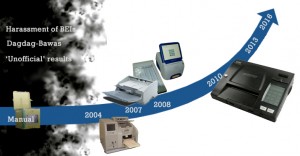You think a return to manual vote counting is good? You need a history lesson.
In the early years of automation, the need to minimize human intervention in the vote counting and canvassing aspects of elections was accepted doctrine. Human intervention at the precinct level introduces vulnerability to fraud at two levels: first, in the tabulation of the votes garnered by each candidate, i.e., the preparation of election returns which could be influenced by fatigue or manipulated by fraud, sometimes both; and second, in the hand-carrying of the finished election returns which could be hijacked, replaced, or even totally lost, on the way to the canvassing stations.
The pre-2004 solution, therefore, was to centralize automated counting and situate it, as much as possible, in the same place where the canvassing was to take place. In that way, the automatically generated election returns – essentially the print out from the automated counting machines – could then be hand-carried to the appropriate canvassing unit, in full view of everyone. This solution minimized human fraud and error in the production of the election returns, and ensured that no one could hijack the election returns while they were in transit.
Unfortunately, this solution was not without its problems. Ballots that had to be transported from the precincts to the counting centers could still be hijacked; and even when they were safely within the counting center premises, the queues of precincts waiting for their turn at the counting machines rapidly grew to unwieldy lengths. The legalization of electronic transmission in 2008 changed that.
With the updated automation law, counting machines could be placed in the precincts themselves and the results could then be electronically transmitted to the canvassing centers. Automatically generated election returns plus near instantaneous over-the-air transmission to canvassing centers meant that the results would no longer be subject to human intervention or manipulation.
This new way of doing things had three significant side-effects. First, the automation of the process drastically cut down on the time spent on manual counting, manual preparation of election returns, manual transmittal of returns to the canvassing centers, and ultimately, the proclamation of candidates. Counting no longer had to take upwards of six hours; the accuracy of election returns would no longer be subject to human fraud and fatigue; the election returns were no longer in danger of being hijacked en route; and the electorate no longer had to suffer through weeks of “unofficial, incomplete results” as most winners were proclaimed in a matter of hours.
Second, automation made it possible for the first time for the broader public – anyone with an internet connection really – to keep tabs on the progress of the vote counting, thus giving everyday people access to information that they used to get only via the filters of spin provided by political operators and publicists.
And third, because each ballot is taken a picture of at the time of casting, the recount process becomes a simple matter of comparing encrypted ballot images with election returns. Contrary to what most losing candidates would have the people believe, this legal remedy remains available to them under the automated system.
Reverting to a manual counting plus electronic transmission and canvassing automation model now would practically eliminate those gains.
Manual counting may have a strong nostalgic appeal, but the reality of manual counting is that it is a long, exhausting process for the teachers who do it. Worse, it subjects them to threats and intimidation, and in some cases, the possibility of death. When teachers are responsible for interpreting ballots and recording results on election returns, it is inevitable that the people who will stop at nothing to win will focus all their malevolence on those teachers. And no, giving them more money won’t solve that problem, Mr. L.
And to transfer these manually prepared returns to digital format, i.e., encoding, simply creates another entry point for vulnerability at more than a hundred thousand precincts nationwide. Again, because human intervention is made a linchpin of the process, those humans are suddenly at risk once more. When you increase the number of points where the system can be compromised, you correspondingly increase the likelihood of successful attempts. You don’t need to be an IT expert to see that.
And all for what? So that politicians can have more opportunities to delay their loss without having to face a fair recount process?
Think again.


